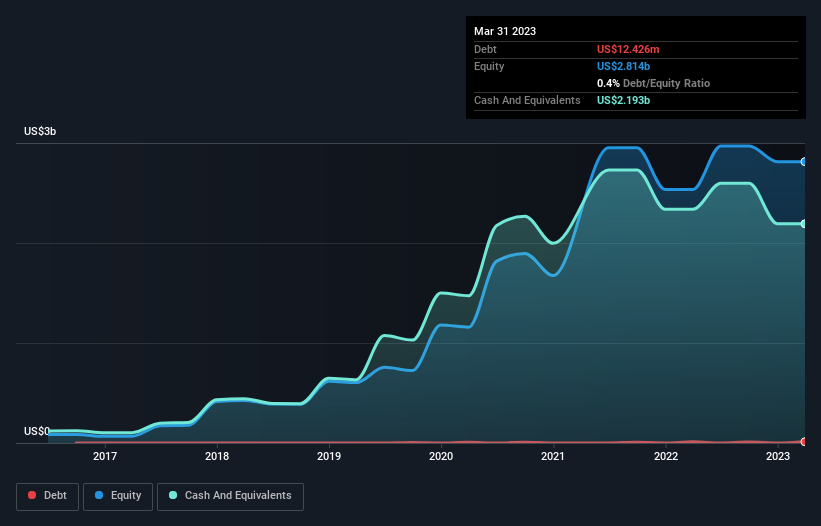
The external fund manager backed by Berkshire Hathaway's Charlie Munger, Li Lu, makes no bones about it when he says 'The biggest investment risk is not the volatility of prices, but whether you will suffer a permanent loss of capital.' It's only natural to consider a company's balance sheet when you examine how risky it is, since debt is often involved when a business collapses. As with many other companies argenx SE (EBR:ARGX) makes use of debt. But the more important question is: how much risk is that debt creating?
What Risk Does Debt Bring?
Generally speaking, debt only becomes a real problem when a company can't easily pay it off, either by raising capital or with its own cash flow. If things get really bad, the lenders can take control of the business. However, a more frequent (but still costly) occurrence is where a company must issue shares at bargain-basement prices, permanently diluting shareholders, just to shore up its balance sheet. By replacing dilution, though, debt can be an extremely good tool for businesses that need capital to invest in growth at high rates of return. The first step when considering a company's debt levels is to consider its cash and debt together.
View our latest analysis for argenx
What Is argenx's Net Debt?
The image below, which you can click on for greater detail, shows that at December 2022 argenx had debt of US$12.4m, up from US$11.5m in one year. But it also has US$2.19b in cash to offset that, meaning it has US$2.18b net cash.

A Look At argenx's Liabilities
We can see from the most recent balance sheet that argenx had liabilities of US$302.3m falling due within a year, and liabilities of US$18.3m due beyond that. Offsetting these obligations, it had cash of US$2.19b as well as receivables valued at US$277.3m due within 12 months. So it can boast US$2.15b more liquid assets than total liabilities.
This short term liquidity is a sign that argenx could probably pay off its debt with ease, as its balance sheet is far from stretched. Succinctly put, argenx boasts net cash, so it's fair to say it does not have a heavy debt load! When analysing debt levels, the balance sheet is the obvious place to start. But ultimately the future profitability of the business will decide if argenx can strengthen its balance sheet over time. So if you want to see what the professionals think, you might find this free report on analyst profit forecasts to be interesting.
Over 12 months, argenx reported revenue of US$639m, which is a gain of 68%, although it did not report any earnings before interest and tax. With any luck the company will be able to grow its way to profitability.
So How Risky Is argenx?
We have no doubt that loss making companies are, in general, riskier than profitable ones. And we do note that argenx had an earnings before interest and tax (EBIT) loss, over the last year. And over the same period it saw negative free cash outflow of US$967m and booked a US$511m accounting loss. Given it only has net cash of US$2.18b, the company may need to raise more capital if it doesn't reach break-even soon. With very solid revenue growth in the last year, argenx may be on a path to profitability. By investing before those profits, shareholders take on more risk in the hope of bigger rewards. The balance sheet is clearly the area to focus on when you are analysing debt. However, not all investment risk resides within the balance sheet - far from it. To that end, you should be aware of the 1 warning sign we've spotted with argenx .
When all is said and done, sometimes its easier to focus on companies that don't even need debt. Readers can access a list of growth stocks with zero net debt 100% free, right now.
New: AI Stock Screener & Alerts
Our new AI Stock Screener scans the market every day to uncover opportunities.
• Dividend Powerhouses (3%+ Yield)
• Undervalued Small Caps with Insider Buying
• High growth Tech and AI Companies
Or build your own from over 50 metrics.
Have feedback on this article? Concerned about the content? Get in touch with us directly. Alternatively, email editorial-team (at) simplywallst.com.
This article by Simply Wall St is general in nature. We provide commentary based on historical data and analyst forecasts only using an unbiased methodology and our articles are not intended to be financial advice. It does not constitute a recommendation to buy or sell any stock, and does not take account of your objectives, or your financial situation. We aim to bring you long-term focused analysis driven by fundamental data. Note that our analysis may not factor in the latest price-sensitive company announcements or qualitative material. Simply Wall St has no position in any stocks mentioned.
About ENXTBR:ARGX
argenx
A biotechnology company, engages in the developing of various therapies for the treatment of autoimmune diseases in the United States, Japan, Europe, Middle East, Africa, and China.
Flawless balance sheet with high growth potential.


